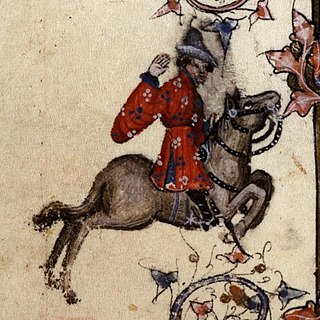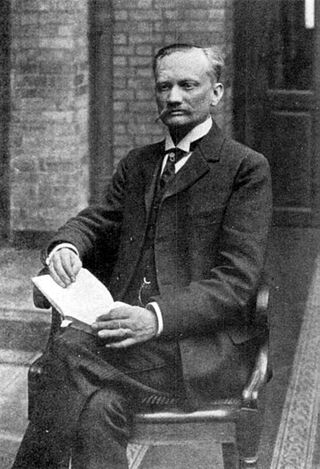Related Research Articles

This article contains summaries and commentaries of the 100 stories within Giovanni Boccaccio's The Decameron.

Samson was the last of the judges of the ancient Israelites mentioned in the Book of Judges and one of the last leaders who "judged" Israel before the institution of the monarchy. He is sometimes considered as an Israelite version of the popular Near Eastern folk hero also embodied by the Sumerian Gilgamesh and Enkidu, as well as the Greek Heracles. Samson was given superhuman powers by God in the form of extreme strength.

"The Merchant's Tale" is one of Geoffrey Chaucer's Canterbury Tales. In it Chaucer subtly mocks antifeminist literature like that of Theophrastus ("Theofraste"). The tale also shows the influence of Boccaccio, Deschamps' Le Miroir de Mariage, Roman de la Rose by Guillaume de Lorris, Andreas Capellanus, Statius, and Cato. The tale is found in Persia in the Bahar Danush, in which the husband climbs a date tree instead of a pear tree. It could have arrived in Europe through the One Thousand and One Nights, or perhaps the version in book VI of the Masnavi by Rumi. Though several of the tales are sexually explicit by modern standards, this one is especially so. Larry Benson remarks:
The central episode of the Merchant's Tale is like a fabliau, though of a very unusual sort: It is cast in the high style, and some of the scenes are among Chaucer's most elaborate displays of rhetorical art.

Lucas van Leyden, also named either Lucas Hugensz or Lucas Jacobsz, was a Dutch painter and printmaker in engraving and woodcut. Lucas van Leyden was among the first Dutch exponents of genre painting and was a very accomplished engraver.
A fabliau is a comic, often anonymous tale written by jongleurs in northeast France between c. 1150 and 1400. They are generally characterized by sexual and scatological obscenity, and by a set of contrary attitudes—contrary to the church and to the nobility. Several of them were reworked by Giovanni Boccaccio for the Decameron and by Geoffrey Chaucer for his Canterbury Tales. Some 150 French fabliaux are extant, the number depending on how narrowly fabliau is defined. According to R. Howard Bloch, fabliaux are the first expression of literary realism in Europe.

"The Reeve's Tale" is the third story told in Geoffrey Chaucer's The Canterbury Tales. The reeve, named Oswald in the text, is the manager of a large estate who reaped incredible profits for his master and himself. He is described in the Tales as skinny, bad-tempered, and old; his hair is closely cropped reflecting his social status as a serf. His sword is rusty while he rides a fine gray horse called Scot. The Reeve is a skilled carpenter, a profession mocked in the previous "Miller's Tale". Oswald responds with a tale that mocks the Miller's profession.

Joseph Bédier was a French writer and historian of medieval France.
Rutebeuf was a French trouvère.

Sam Dingle is a fictional character from the British television soap opera Emmerdale, played by James Hooton. He made his first appearance in the episode broadcast on 14 February 1995.

The Baby of Mâcon is a 1993 historical drama film written and directed by Peter Greenaway, and starring Ralph Fiennes, Julia Ormond and Philip Stone, in his final film appearance.
The Snow-child is a widespread European folktale, found in many medieval tellings.

Elizabeth Frankenstein is a fictional character first introduced in Mary Shelley's 1818 novel Frankenstein; or, The Modern Prometheus. In both the novel and its various film adaptations, she is the fiancée of Victor Frankenstein.
De Bérangier au lonc cul is a medieval French fabliau. There are two versions of the fabliau: one by Guèrin and one anonymous.
The Folie Tristan d’Oxford, also known as the Oxford Folie Tristan, The Madness of Tristan, or Tristan’s Madness, is a poem in 998 octosyllabic lines written in Anglo-Norman, the form of the Norman language spoken in England. It retells an episode from the Tristan legend in which Tristan disguises himself as a madman to win his way back to Ysolt. The poem can be dated to the period 1175–1200, but the name of the author is unknown. It is not to be confused with the Folie Tristan de Berne, a different medieval poem on the same subject, each work taking its name from the city in which the manuscript is now kept.

Guillaume d'Angleterre is a 12th-century epic poem in Old French, consisting of 3310 lines. The author identifies himself as Crestiiens on the first line of the poem, which has caused a great deal of debate in the romance philological community as to whether the author is Chrétien de Troyes.
La Mule sans frein or La Demoiselle à la mule is a short romance dating from the late 12th century or early 13th century. It comprises 1,136 lines in octosyllabic couplets, written in Old French. Its author names himself as Païen de Maisières, but critics disagree as to whether this was his real name or a pseudonym. La Mule is an Arthurian romance relating the adventures, first of Sir Kay, then of Sir Gawain, in attempting to restore to its rightful owner a stolen bridle. It is notable for its early use of the "beheading game" theme, which later reappeared in the Middle English romance Sir Gawain and the Green Knight. It is sometimes seen as a skit or burlesque on earlier romances, especially those of Chrétien de Troyes, but it has also been suggested that it might have been written by Chrétien himself.
Joufroi de Poitiers or Joufrois is a 13th-century French romance in 4613 octosyllabic verses. Only one manuscript of this work is preserved, in the Royal Library, Copenhagen, and this gives the romance in an incomplete form.
"The knight who could make cunts speak" is a French fabliau. Seven versions of it remain, including one in MS Harley 2253.
In fabliaux, bacon is one of the most commonly consumed foodstuffs, alongside capons and geese, cakes, bread, and wine.
References
- ↑ Cuddon, John Anthony; Claire Preston (1999). "Fabliau". The Penguin Dictionary of Literary Terms and Literary Theory (4 ed.). Penguin. p. 301. ISBN 978-0-14-051363-9.
- ↑ "Cod. 354 (A) 1.58 De Richeut, 13. Jh. (ca.) (Codex Inhalt)". Burgerbibliothek of Berne – Online Archive Catalogue. Retrieved 2024-11-24.
- ↑ Vernet, André. “Fragments d’un Moniage Richeut?” Études de langue et de littérature du Moyen Âge: offertes à Felix Lecoy par ses collègues, ses élèves et ses amis. Paris: Champion, 1973, pp. 585-597.
- ↑ Horton, Ingrid D. Engendering Vice: The Exemplarity of the Old French Fabliaux. Diss. U. of Kansas, 2007. Ann Arbor: UMI, 2008.